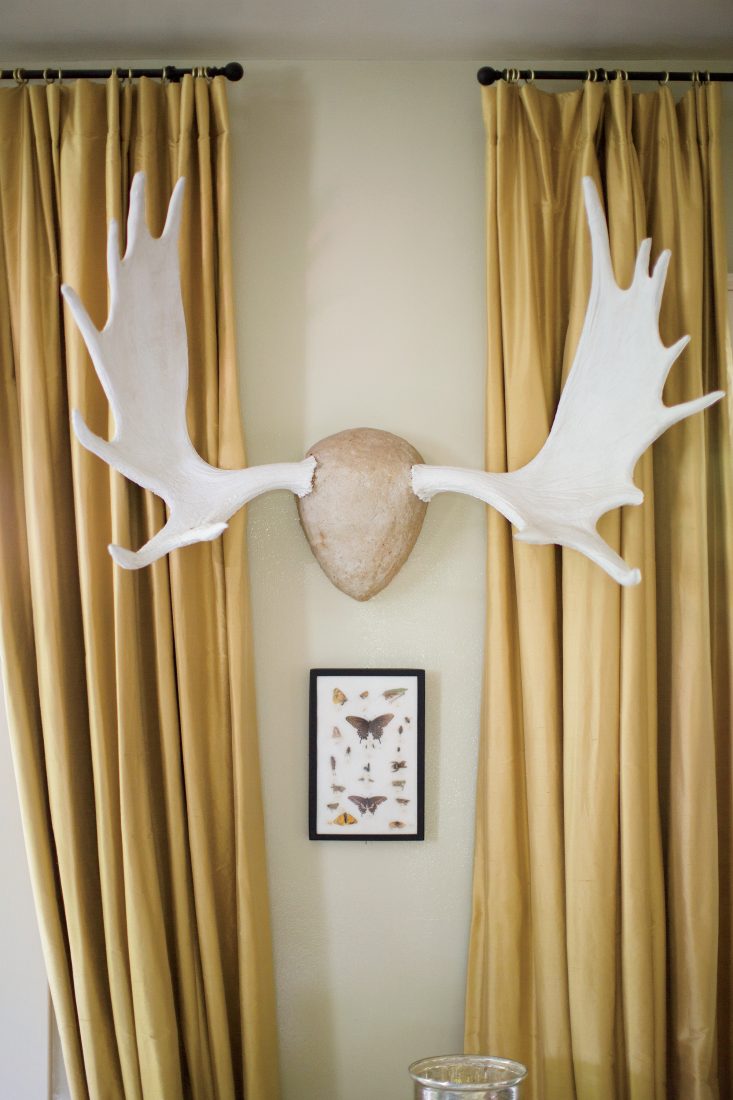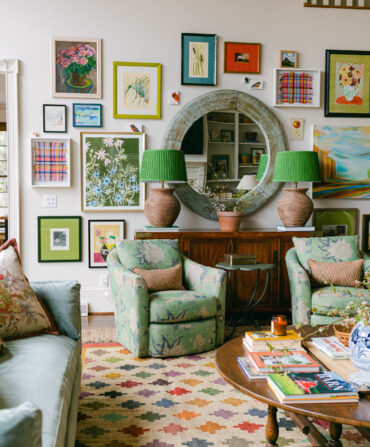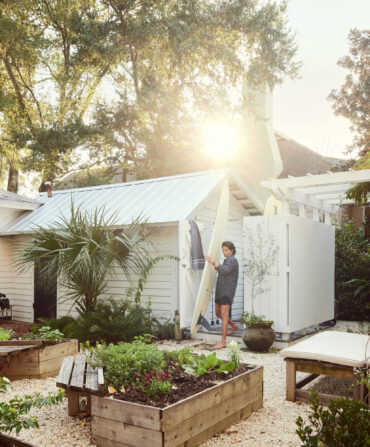It’s little wonder that Abby Kasonik and Roderick Coles live in a gorgeous home. A painter known for her moody, dreamlike abstracts and landscapes, Kasonik is fluent in the language of color and composition. And Coles, proprietor of the Curious Orange Store, an antiques and interiors shop in Charlottesville, Virginia, devotes his days to the pursuit of unforgettable objects, everything from nineteenth-century Louis XV slipper chairs to Brutalist sculpture. But what animates the home’s decor is the passionate engagement the two bring to their domestic surroundings.
“This house has grown up with us over the years,” Kasonik says. “I’m very attached to this place. It feels like a member of the family.”
Their dwelling is a white-painted 1933 brick bungalow in Earlysville, a peaceful hamlet in the Blue Ridge foothills about ten miles north of Charlottesville. As a freshly minted art-school grad eighteen springs ago, Kasonik bought the not-quite-2,000-square-foot fixer-upper on nearly three acres from a pinball-machine repairman and his family. A sign beneath a hole in the kitchen ceiling read, PLASTER FALLING ZONE. Kasonik’s mother gave her a home-repair handbook and told her, “Don’t electrocute yourself.”
In the intervening years, she and Coles, who moved in eight years ago, have transformed the roadside house into a charming cottage hidden behind sixteen-foot-tall skip laurel hedges and cloaked in climbing hydrangea.

Photo: Patricia Lyons
A carved conversation piece in the den
One of the most striking improvements was flip-flopping the entry. What was once a traffic-facing front porch is now a gracious, plant-filled, screened affair off the living room. To enter the home, you crunch along a pea-gravel drive, past a shaded side garden, park, and stroll through a circular entry. A stone fountain burbles in the center near the foot of a broad wooden stairway framed by two large boxwoods. The stairs climb to what was once the rear porch—the kitchen porch, which means the front door opens directly into one of the home’s least formal and most intimate spaces. There’s something charming and practical about this arrangement. It seems to suit the couple’s confident, relaxed manner.
Kasonik and Coles are consummate Southern collectors who prefer a mix of old and new objects, masculine and feminine touches, and high and low style. Though their tastes generally align, the two differ in disposition, which may be why their partnership works so well: He’s a high-energy aesthete who loves a bold statement; she’s more reserved and reflective. Kasonik often serves as a filter to Coles’s enthusiasm. After falling in love with a lounge chair by the twentieth-century Italian designer Gigi Radice, Coles tried bringing it home, but Kasonik shot down the idea. “It’s the coolest chair in the world,” he says, but then admits she was right. “I like fancy furniture, but in a house like this, there’s a fancy limit.”
A home doesn’t have to be fancy or formal to move you. The secret is the way the furnishings, collectibles, and curiosities combine to subtly reflect the aspirations of its inhabitants. Everything in the home has a personal connection, and everything comes with a story.
Take the wooden horse’s head perched atop a den cabinet, a gift from Kasonik’s mother purchased from family friend and longtime Charlottesville designer and antique dealer Kenny Ball. Coles and his friends love debating the piece’s provenance. Is it French or Asian or some combination created during colonization? Was it originally a farrier’s trade sign? Then there’s the dining table from Sweden, made from planks of blond oak. Though it appears custom made for the narrow dining room, it was, in fact, part of the support structure in a shipping container filled with light fixtures. Coles purchased it from an Atlanta importer and altered it to dining-table size.

Photo: Patricia Lyons
The living room, with its moose antlers gessoed white
“I bought that,” Coles says, gesturing to an antique armchair in the living room, “at auction for forty dollars. It was in a box in twenty-five pieces.” Turquoise velvet now covers the stripped giltwood frame. The chair pops alongside the living room’s white slipcovered sofa and armchair. Much of the home’s upholstered seating is comfortable and white, an intentional choice Kasonik made when she first moved in. The slipcovers offer a neutral background for the couple’s colorful art and accessories. “Besides,” Kasonik says, “I can move these from room to room, and they go with everything. I love rearranging furniture.”
Designing and editing vignettes within rooms is a passion passed along by Kasonik’s mother, who lives in Charlottesville in a two-hundred-year-old Federal-style house that once belonged to the Confederate commander John Mosby.
As if on cue, the couple’s nanny enters with their one-year-old daughter, Margaux. “Watch this,” Coles says, plopping the toddler down in front of a tiny chair. She squeals and begins sliding the antique across the floor like a first-time ice skater behind a five-gallon bucket.
The layers in this home encompass more than objects. They’re layers of history and hard work and even a predisposition for rearranging furniture. They also include imperfection. “It’s like when somebody chips a chair, and you try to match the color,” Kasonik says. “Those imperfections are part of the narrative.”
In the couple’s home office, above a zinc-topped French stretcher table that holds an iMac and photos of Margaux, hangs a giant leaf, dried and pressed and framed by the couple. “See how it has fallen?” Coles says. “It slipped in its frame, and now it’s perfect.”
“We could have spent hours trying to get that off-center,” Kasonik adds.
Proving that if you’re open to imperfection, sometimes the perfect reveals itself.









